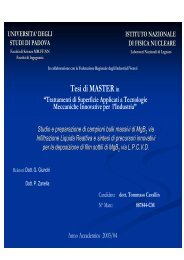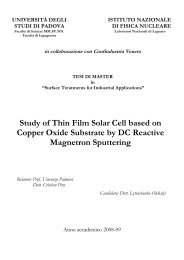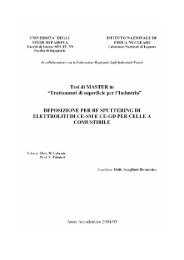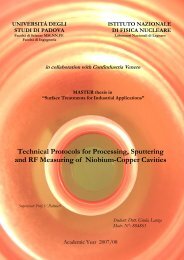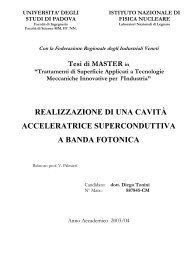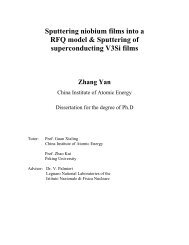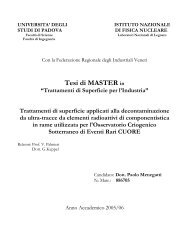Magnetron sputtering of Superconducting Multilayer Nb3Sn Thin Film
Magnetron sputtering of Superconducting Multilayer Nb3Sn Thin Film
Magnetron sputtering of Superconducting Multilayer Nb3Sn Thin Film
You also want an ePaper? Increase the reach of your titles
YUMPU automatically turns print PDFs into web optimized ePapers that Google loves.
1008038.5°{110}69.6°{211}sample1sample2sample3elative intensity60402055.5°{200}82.5°{220}95.1°{310}121.7°{321}040 50 60 70 80 90 100 110 120 130 140Angle[degree]Fig. 2.42 the XRD result <strong>of</strong> Run 7According to the result <strong>of</strong> the XRD experiment from Fig. 2.36 to Fig. 2.42, thereare some abnormal peaks, such as {211} <strong>of</strong> sample2 <strong>of</strong> run3, {211} <strong>of</strong> sample3 <strong>of</strong>run2. All <strong>of</strong> the marked peaks are the crystal plane <strong>of</strong> the Nb. The unmarked peaks <strong>of</strong>Run 3 sample 1 may be that <strong>of</strong> Oxygen element, the unmarked peaks <strong>of</strong> Run 7 sample1 may be that <strong>of</strong> NbO, and the unmarked peaks <strong>of</strong> Run 5 sample 2 may be that <strong>of</strong>NbO and Oxygen, which should be investigated in the next step.Fig.2.43 The mirror reflection <strong>of</strong> the photonThe peaks <strong>of</strong> the figures <strong>of</strong> the XRD results are formed by the crystal, which canbe explained by W. H. Bragg as shown in the Fig.2.43. If we regard the crystal planesas mirrors, constructive interference is observed when the path difference between thetwo reflected beams is nλ. The path difference <strong>of</strong> the photon action on the adjacentcrystal plane is:38



